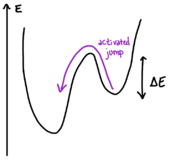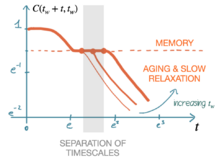T-7
Goal: The goal of these problems is to understand some features of glassy dynamics (power laws, aging) in a simplified single particle description, the so called trap model.
Techniques: extreme value statistics, asymptotic analysis.
A dynamical dictionary: energy barriers, out-of-equilibrium, aging
- Noise and Langevin dynamics. In problems 5 and 6 we have characterized the energy landscape of the spherical -spin, and showed that it is made by plenty of stationary points where gradient descent can get stuck. In presence of noise,
the random terms kick the systems in random directions in configuration space, allowing to escape from stationary points. In Langevin dynamics, a Gaussian vector at each time , uncorrelated from the vectors at other times , with zero average and some constant variance proportional to temperature.
- Activation and Arrhenius law. When the noise in the Langevin dynamics is weak (temperature is small), the dynamics does not get stuck in local minima forever, but for very large time. This time depends crucially on the energy barrier which separate the minimum from the other configurations (see Fig 6.1). The Arrhenius law states that the typical timescale required to escape from a local minimum through a barrier of height with thermal dynamics with inverse temperature scales as . A dynamics made of jumps from minimum to minimum through the crossing of energy barriers is called activated .
- Equilibrating dynamics. A system evolving with thermal dynamics (e.g. Langevin dynamics) equilibrates dynamically if there is a timescale beyond which the dynamical trajectories sample the configurations of the system with the frequency that is prescribed by the Gibbs Boltzmann measure, , where is the inverse temperature associated to the noise. At equilibrium, one-point functions in time, like the energy of the system, reach a stationary value (the equilibrium value predicted by thermodynamics at that temperature), while two-point functions like the correlation function
- Out-of-equilibrium and aging. In some systems the equilibration timescale is extremely large/diverging with some parameter of the model (like ), and for very large time-scales the dynamics is out-of-equilibrium . In glassy systems, out-of-equilibrium dynamics is often characterized by aging: the relaxation timescale of a system (how slow the system evolves) depends on the age of the system itself (on how long the system has evolved so far). Aging can be seen in the behaviour of correlation function, see Fig 7.2: the timescale that the system needs to leave the plateau increases with the age of the system , meaning that the system is becoming more and more slow as it gets more and more old.
- Ergodicity breaking and condensation. Compute the average trapping time (averaging between the traps) and show that there is a critical value of below which it diverges, signalling a non-ergodic phase (the system needs infinite time to explore the whole configuration space). Consider a dynamics running from time to some later time : compute the typical value of the maximal trapping time encountered in this time interval, assuming that the system has spent exactly a time in each visited trap . Show that in the non-ergodic phase . Why is this interpretable as a condensation phenomenon?
- Aging and weak ergodicity breaking. Assume now that the trap represent a collection of microscopic configurations having self overlap . Assume that the overlap between configurations of different traps is . Justify why the correlation function can be written as
In the non-ergodic regime, one finds:
Why is this an indication of aging? Show that
- Extra: Power laws. Study the asymptotic behavior of the correlation function for and and show that the dynamics is slow, characterized by power laws.
- REM: distribution of depths of traps. In the REM, the energy levels are independent Gaussian variables. In Lecture 1, we have shown that the Ground State has the statistics of , with Gumbel. The distribution of the smallest energies values among the can be assumed to be the same. Show that:
- REM: trapping times. The Arrhenius law states that the time needed for the system to escape from a trap of energy density and reach a configuration of zero energy density is . This is a trapping time. Given the energy distribution , determine the distribution of trapping times : what plays the role of ? Is the non-ergodic transition in the TRAP model consistent with what we know about the REM?
- Extra: p-spin and the “trap” picture. In Problems 6, we have seen that the energy landscape of the spherical -spin is characterized by the threshold energy, below which plenty of minima appear. Explain why the trap model corresponds to the following picture for the dynamics: the system is trapped into minima below the threshold for exponentially large times, and then jumps from minimum to minimum passing through the threshold energy.
Problems
In the first of these problems, we discuss the main features of the trap model, a model for glassy dynamics. In the second problem, we discuss the interpretation of the model, using what we know about the energy landscape of the REM and spherical -spin models.
Problem 7.1: a simple model for aging
The trap model is an abstract model for the dynamics in complex landscapes studied in [1] . The configuration space is a collection of traps labeled by having random depths/energies (see sketch). The dynamics is a sequence of jumps between the traps: the system spends in a trap an exponentially large time with average (the probability to jump out of the trap in time is .). When the system exits the trap, it jumps into another one randomly chosen among the . The average times are distributed as
where is a parameter. In this exercise, we aim at understanding the main features of this dynamics.
Problem 7.2: Motivating the model: from landscapes to traps
In this exercise, we aim at understanding why the trap model is a good effective model for the exploration of the energy landscape of the models that we have studied so far. We focus on the REM.
Check out: key concepts
Aging, activation, time-translation invariance, out-of equilibrium dynamics, power laws, decorrelation, condensation, extreme values statistics (typical values of minima).






















![{\displaystyle [t,t+dt]}](https://wikimedia.org/api/rest_v1/media/math/render/svg/66dc1fb4c50c66c3b96beb9a0ef2bb4ab4b06c08)









![{\displaystyle C(t_{w}+t,t_{w})=q_{EA}\Pi (t,t_{w})+q_{0}\left(1-\Pi (t,t_{w})\right),\quad \quad \Pi (t,t_{w})={\text{probability that systems has not jumped in }}[t_{w},t_{w}+t].}](https://wikimedia.org/api/rest_v1/media/math/render/svg/bd488c836e56fa0a018bdac5506dc6b3ca8fd113)











![{\displaystyle P_{N}^{\text{extrm}}(E)\approx C_{N}{\text{exp}}\left[{\sqrt {2\log 2}}E\right],\quad \quad E<0,\quad \quad C_{N}{\text{ normalization}}}](https://wikimedia.org/api/rest_v1/media/math/render/svg/9525f87ff0e867f332a94418a9cb02a96647c2f6)


